Horsekeeping takes time and dedication, no matter where you live, but the differences can be huge! Here, we’ll travel to California and Kentucky to meet Mia and Lilli and learn about their horse care routines.
Lilli lives in the heart of Kentucky horse country, famous for its Thoroughbred horses and beautiful horse farms. It’s picture-perfect, and the perfect place to live if you love horses. Mia lives in California, home to 40 million people—and the most horses of any state! While Southern California may be better known for its beautiful beaches and busy freeways, there are quite a few riding stables to be found there as well.
Horsekeeping in the Heart of Horse Country
Eleven-year-old Lilli Seto has grown up with horses. She became a member of the United States Pony Clubs at the age of 5, and has two horses: an American Quarter Horse mare named Lucy and a Welsh Pony called Olaf. She does eventing and western dressage, and even does some cattle work with Olaf.
Where They Live: Lucy and Olaf were previously boarded at a Pony Club Riding Center and now live on Lilli’s grandparents’ farm outside of Louisville, Ky. It’s a 6-acre property with a three-stall barn and paddocks all around the house, including a gravel dry lot.
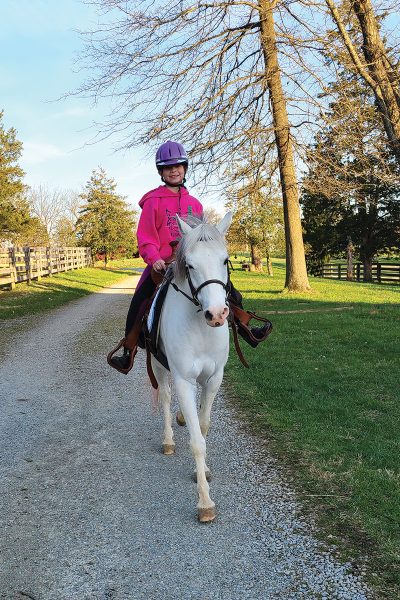
Her mom grew up on the farm, and Lilli has always helped care for the retired horses there. Now she is taking care of Lucy and Olaf, along with their donkey friend named Mossy. She also helps take care of the chickens on the farm.
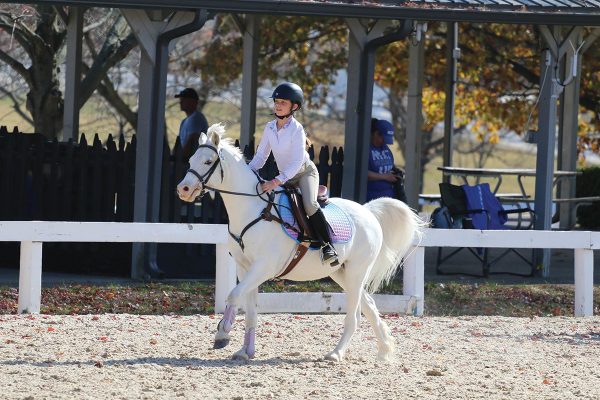
Barn Routine: At the farm, Lilli cleans stalls and paddocks and prepares the horses’ feed. She also makes sure the barn aisle stays clean. An important job Lilli does is to walk around the paddocks and fields looking for fallen tree branches or anything that could hurt a horse. Checking water troughs and buckets is another job that Lilli helps with. Her favorite barn chore is making up the horses’ feed.
“It’s kind of like baking, and I like to bake!” she says.
Lilli’s horses get feed and supplements in the morning and evening, and they eat hay throughout the day. Out in the paddock she puts the hay all around in different piles so that the horses get a little extra exercise as they eat. While Kentucky is famous for its bluegrass that is ideal for horsekeeping, Lilli has to be careful that Lucy and Olaf don’t eat too much of it. Both are easy keepers, and too much rich grass could cause health problems for them.
“It’s nice having horses at home so we can do things our own way,” Lilli says. “Our horses have more turnout and are happier.”
During the school year, it’s a little harder to fit everything in, but Lilli helps with evening feed and chores. Chores take a lot of time, but Lilli explains that it’s important to do the chores first before riding.
It can be tough for kids to balance school and riding. To make time to ride, Lilli says that she doesn’t do a lot of after-school activities (except for art club once a week) so that she can focus on riding.
“If I’m not at school, I’m mostly here at the barn,” she says.
Horsekeeping out at the farm, Lilli loves that she can hop on her pony bareback and ride down the road. While horses are great friends, it’s fun to ride with other kids too, so they often trailer out for lessons, Pony Club activities, camps and shows.
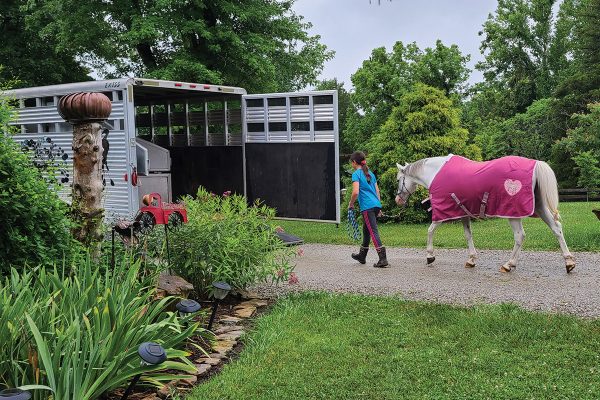
Horses in the Big City
Mia Folk is 15 years old. She has been riding since she was 8 and started off in 4-H and Pony Club doing both western and English. She has done dressage, jumping and eventing and is now focused on competing in dressage. Before moving to Southern California, Mia lived in Oregon and Idaho, where she first began riding.
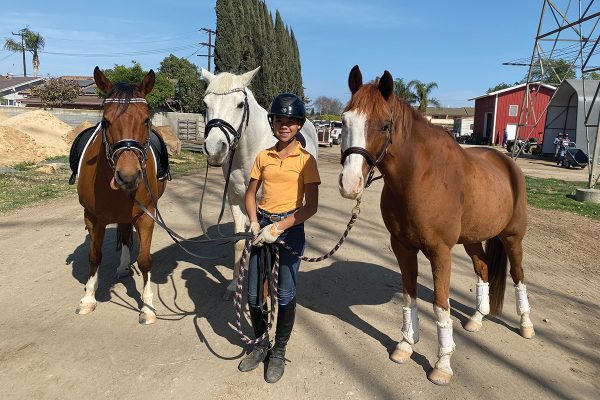
Mia has one horse and two ponies, including Jasper, a 21-year-old Arabian-Lippizaner cross, and Havana, a 13-hand pony Mia adopted and competed all the way to First Level in dressage. Both Havana and Jasper are retired from competing now but give lessons to beginning kids.
Her newest addition is a German Riding Pony named Alastor.
“He is my main competition horse, and he works so hard for me,” says Mia. After just under a year together, they qualified for the 2022 USEF Children’s Dressage National Championship at the U.S. Dressage Festival of Champions and traveled all the way to Chicago to compete.
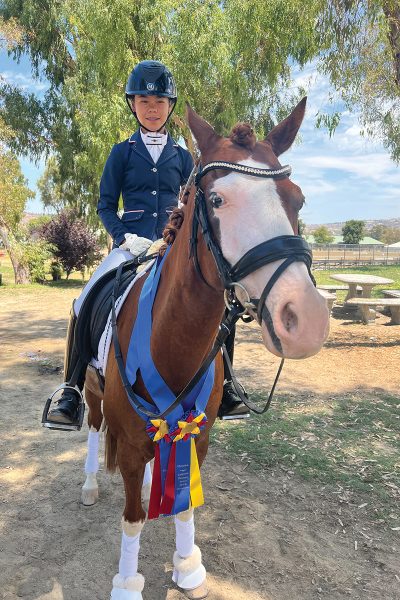
Where They Live: Mia’s horses live at an equestrian center with close to 200 stalls. There are some box stalls and barns, but most of the horses live in individual outdoor pipe stalls. Mia’s horses each have a 12′ x 24′ stall.
In Southern California, the intense sun can be a concern, so making sure the horses have shade is important—especially for Alastor, since he has a blue eye and a pink nose that can easily get sunburned. Alastor’s stall is fully covered, and the stalls that Jasper and Havana are in are half covered.
One thing Mia especially appreciates for her horses is that the center has access to grazing, which is not always easy to find when horsekeeping in Southern California, especially near a big city.
“It is nice because the place has grass all around so we are able to graze them and even turn them out in a big enclosed grassy pasture,” she says.
Barn Routine: Mia is at the barn seven days a week. Although the boarding barn provides some horsekeeping basics, she is involved with all of her horses’ care.
“I do everything for my horses daily,” says Mia. “Although the workers at the barn clean the stalls once a day, I still pick out their stalls when I get there. The barn gives them hay twice a day, but I make sure to always give them a snack and I make all their grain and give them all their needed supplements. I brush and clean them every day.”
Mia makes sure that her horses get enough exercise and that they get out of their stalls to stretch their legs.
“Every day, my horses are being ridden in a lesson or I just ride them for fun,” she says. “I also hand-walk them and turn them out. When I’m at the barn every day, I make sure that they get out as long as possible.”
Mia takes lessons on Wednesdays, Fridays and Saturdays with her dressage trainer, Stephanie Field, and spends the day at the barn. While she’s there, Mia helps her trainer as much as she can, tacking up horses, turning them out, and assisting with other chores like clipping or blanketing. On non-lesson days, Mia’s mom takes her to the barn after work.
“I’m able to spend all the hours at the barn because I’m homeschooled,” explains Mia. “Having three horses takes a lot of time, and I go to shows about twice a month.”
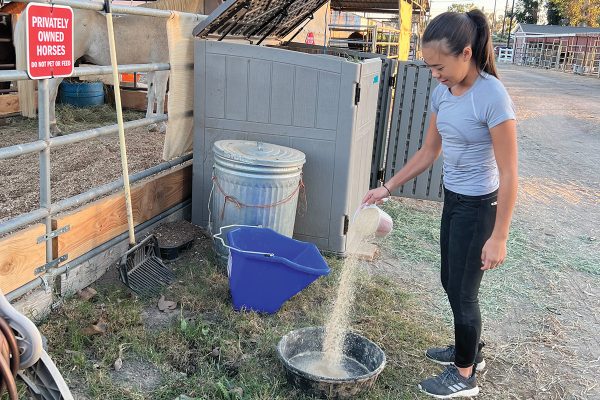
Mia enjoys helping the younger riders who take lessons at the barn. She has also made friends throughout the show season, and they have fun hanging out together at shows.
Competition is one of Mia’s favorite things about riding.
“I love working hard to learn something and to see how I do in a show,” she says. “It lets me know how much harder I need to work.”
Horses are Mia’s happy place, no matter where she lives.
“It is really nice to be able to still have my horses in the city,” she says. “I lived in Idaho and Oregon with my horses, and although it was so different because I was able to just take them out on trail rides every day, I am still lucky that my barn is so big that we can walk around the whole place and not feel like we are in the middle of a big city.”
This article about horsekeeping in the city vs. the country appeared in the January/February 2023 issue of Young Rider magazine. Click here to subscribe!


